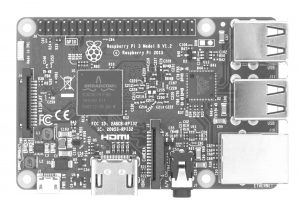 The Raspberry Pi, a small, single-board computer developed by the Raspberry Pi Foundation in the United Kingdom, is celebrating its fifth birthday. The Raspberry Pi Foundation, which was co-founded by Eben Upton, originally developed the Pi to stimulate the study of Computer Science in schools and developing countries in a fun and affordable way.
The Raspberry Pi, a small, single-board computer developed by the Raspberry Pi Foundation in the United Kingdom, is celebrating its fifth birthday. The Raspberry Pi Foundation, which was co-founded by Eben Upton, originally developed the Pi to stimulate the study of Computer Science in schools and developing countries in a fun and affordable way.
On the 29th of February 2012, the sale of the first Raspberry Pi “model 1” started. Selling for just 25 dollars, more than 2 million units of the little “credit card” sized computer were ordered. Due to the high demand the websites of the two companies selling the Pi went offline.
While the first model just had a 700Mhz single core ARM processor and 256MB(A) or 512MB(B) of RAM, the latest “B” version contains a 1.2Ghz 64-bit Quad-core ARM Cortex-A53 processor and 1GB of ram. This makes it roughly ten times faster the original one. Also it now makes the latest version even powerful enough to use as a “simple home computer” and useful for simple tasks such as browsing the internet, watching YouTube videos and writing email.
 The Pi comes standard with an HDMI port for video and audio output making it possible to use every modern monitor or television as a display device.
The Pi comes standard with an HDMI port for video and audio output making it possible to use every modern monitor or television as a display device.
Connecting to a wireless network has become even easier with the “model B 3”, because of its on-board wireless and Bluetooth 4.1 capabilities.
Just like a “real computer” the Raspberry Pi has USB ports (4) to connect any peripheral you like such as a mouse, keyboard or external drives.
What the Pi does not have is on-board storage. The Pi boots from a (micro) SD card. The OS then loads either from a partition on the same SD card, or from an external USB attached drive. The most commonly used OS for the Raspberry Pi is Raspbian, which is a Debian-based Linux operating system and is the Foundation’s officially supported OS. But there are many other third party operating systems available that include Ubuntu MATE, Snappy Ubuntu Core, Windows 10 IoT Core, OSMC, LibreElec, Pinet, RISC OS and even Android.
One of the really nice features of the Pi is the row of 40 GPIO (general purpose input/output) pins that act as an interface between the Pi and the outside world. They make it possible to read input from, say, switches that you can turn on and off or from sensors (for example for measuring temperature, humidity, distance).
They can also be used to send data (output), for example to turn a LED on and off. When the Pi is connected to a network you even have the possibility to control the devices that are connected to it through the internet.

Due to its low cost and high performance and small size the Pi was picked up and embraced by a large community of makers and enthusiasts that did not belong to the initial target market.
Many people started their own projects, of which many are open, based on the Raspberry Pi including: home automation (smart home, domotics or domotica), robotics, drones, Internet of Things (IoT), high-altitude ballooning, media center, game console, web server and even super computer projects.
This last one was even picked up in 2015 by “GCHQ” (the British intelligence and security organisation). In order to make their software engineering community more familiar with the ins and outs of parallel computing they decided to build a Raspberry Pi cluster computer. So the “Bramble” computer was created from a Raspberry Pi cluster that consisted of 8 basic blocks of 8 Pis, a so called “OctaPi”, and two head nodes each containing one Pi, making a total of 66 Raspberry Pis.
Although examples exist of clusters of 144 Pis, a setup with less Pis should be enough to get you started with some distributed computing and big data experiments at home.
These are just some of the examples of what can be done, and exciting new Pi projects arise every day. With a massive online community of thousands of people willing to share their knowledge, with sites containing hundreds of examples, with free software, and in just five years selling more than 11 million Raspberry Pis, it is clear that the Raspberry Pi foundation has succeeded in reaching at least one of its goals: “Making people enthusiastic about Computer Science”!

